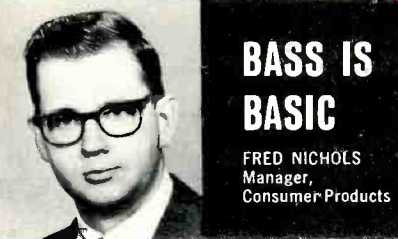
BASS IS BASIC
Number 93 in a series of discussions by Electro-Voice engineers
FRED NICHOLS; Manager, Consumer Products
Creating truly fundamental bass with an acoustic suspension speaker system is often an exercise in frustration. It requires substantial power, plus a speaker that can move extreme distances without distortion. And as the woofer cone area is reduced the problem becomes more and more acute.
Luckily the typical distribution of energy in the lowest octaves for most music is usually modest, so that speakers are called upon to produce deep bass much less often than commonly supposed, even when reproducing organ and orchestral music. Nevertheless, the capability to accurately reproduce the lowest octaves is one greatly sought after and highly prized.
A re-examination of audio basics, primarily inspired by research by A. N. Thiele, has led E-V to develop new speakers based not on the ubiquitous sealed box concept, but rather on a sophisticated analysis of the vented enclosure. The first new system using this basic approach is the Interface: A. Unlike small sealed systems, the woofer excursion for this system actually diminishes as the system approaches resonance, thus permitting an extension of low frequency response without major penalties in efficiency or increased size.
To achieve the low frequency limit of 32 Hz (3 dB down point) from this 6th Order Butterworth-tuned system, research results suggested the use of an 8-inch woofer, matched to the enclosure volume with the equivalent of a 10-inch diameter, 20-foot long vent. But examination of the system reveals neither vent nor duct! Instead a vent-substitute is employed. This takes the form of a 12-inch cone assembly that is controlled in mass and compliance to be the mechanical analogue of the desired acoustic vent system. It has no voice coil or magnet but moves solely in response to the motion of the 8-inch woofer. It is fascinating to watch the 12-inch vent-substitute moving vigorously at 32 Hz in response to the woofer whose motion is barely detectable! In combination with an active equalizer that adds a modest 6 dB boost at 35 Hz, Interface:A extends low frequency response well below that of a sealed system of equivalent size and efficiency, yet without increasing woofer excursion.
The same principles of vented system design have also been applied by Ray Newman, E-V Senior Product Engineer, in creating the new Sentry III monitor system. In this instance, high efficiency for studio use was a major design goal, and it is achieved with a larger enclosure, a 15-inch woofer and a "real" vent. The result is a system capable of low frequency performance uncommon in past high level monitor systems.
For reprints of other discussions in this series, or technical data on any E-V product, write: ELECTRO-VOICE, INC., Dept. 333A 602 Cecil St., Buchanan, Michigan 49107.
a GULTON subsidiary

(Audio magazine, Mar. 1973)
Also see:
Electro-Voice (EV) speakers (Mar. 1972)
Electro-Voice (EV) Sentry III speakers (Dec. 1973)
Electro-Voice Interface:A speaker (Mar. 1976)
= = = =